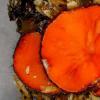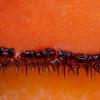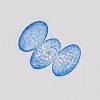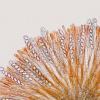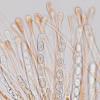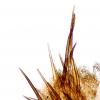
11-04-2016 23:18
 Dartanha Soares
Dartanha Soares
Hi to all,Found this one on decorticated wood (unk

12-04-2016 13:39
Thorben HülsewigHi there,i don't know if i'm right here, but i mak

11-04-2016 12:49
En ramas de poda, sin determinarAscomas muy peque�

09-04-2016 18:40
Pavol PaloHello friends,I would need some literature or pers

09-04-2016 17:15
Adam PolhorskýHello,this fungus (0,9-1,2mm) was found abundantly

09-04-2016 21:23
 Blasco Rafael
Blasco Rafael
Hola,este hongo estaba sobre una rama de Phragmite
I had this Scutellinia labelled as S. scutellata but colleagues, more knowledgeable than I, question the length of setae in the close-up image. It has been suggested that S. crinita would be a better fit.
Checking the data for the two species, there seems little difference in the range of setae length: the longest setae being infrequent in both species.
Here are the data for this fungus:
Apothecium 13mm across.
Spores 20.2-22.6 x 11.9-14.0µm, with medium blunt warts.
Asci 225-255 x 16-18µm.
Setae 250-1300 x 18-60µm.
I would welcome any comments.
Best wishes,
Chris

Are you sure about lenght of hairs ? Or measures are given by colleagues ?
I explain : In my opinion, without measurements, I would suggest S. olivascens (form of spores, form of hairs, hairs bases...).
On the photo of hairs, I suppose a measure around 850-900 µm for the longest one...
In the case of measurements are good, S. scutellata is a big problematic species because :
- Typus was very difficult to study
- scutellata is a generic name, an epithet used for a lot of collections around the world
- DNA results suggest 2 or 3 species in one, near S. pilatii and S. crinita
So, it's possible that this collection could correspond to S. scutellata (in my sense, perhaps not in reality) but it's necessary to have more data about sporal ornementation. Here, it's not possible to say more...
But, S. crinita seems to be not a good hypothesis (measures of spores, hairs bases...)
If you want, you can make a sporogram on little slides and send me an exsiccatum (with slides).
Beñat
Thank you for the detailed reply - not at all straightforward!
The hairs were my measurements and are accurate, however, the larger hairs were infrequent. I will take another sample and measure a larger number.
If I can find out how to do a sporogram, I will send you one with some dried material. Perhaps you could send me an email with your address?
Regards,
Chris
Cordialement,
Chris


